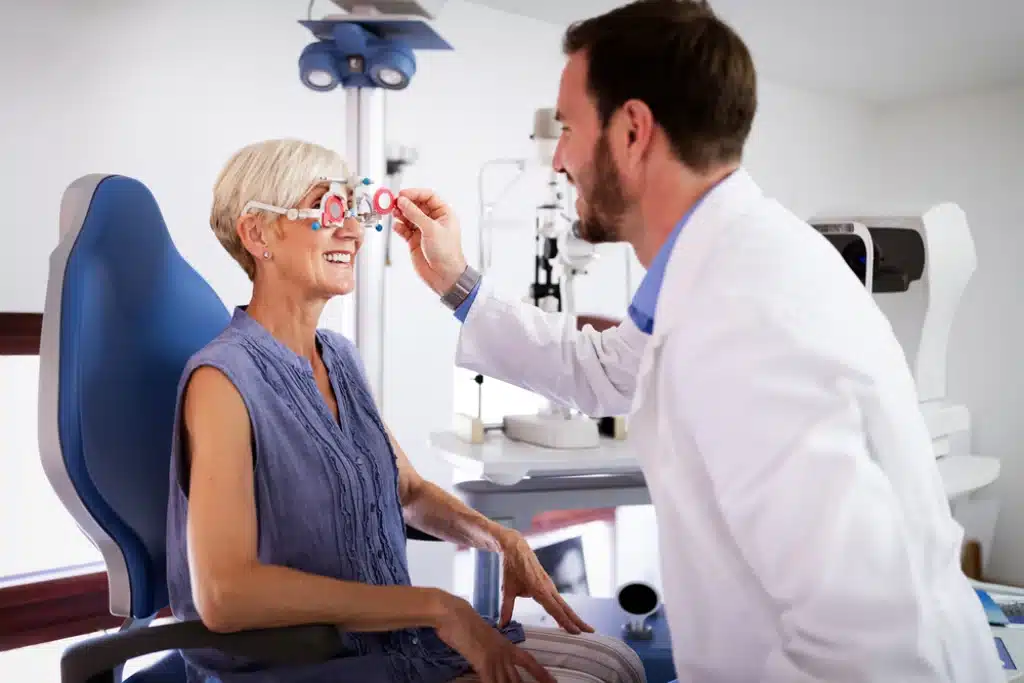Medically Reviewed by: Edward C. Wade, M.D., F.A.C.S.
A Guide to LASIK Eye Surgery and What to Expect
If you meet the qualifications for Houston LASIK, the procedure can greatly improve your life. LASIK, which stands for laser-assisted in situ keratomileusis, is one of the most common and successful eye surgeries to treat astigmatism, nearsightedness, and farsightedness. (Further reading: What is the difference between nearsighted and farsighted?)
Understanding the Requirements for LASIK Surgery
The surgery is almost always successful, but patients must meet the right requirements. (For evaluation: Am I a candidate for LASIK?) You may be advised against LASIK surgery if your prescription is too high. If you have any temporary problems with your eyes such as conjunctivitis or an infection, you must wait until your eyes have fully healed.
Also, your cornea should be the correct thickness, as performing the surgery on a thin or misshapen cornea can affect the results. If your pupils are too large, your doctor may advise you against LASIK, as the surgery could increase your risk of side effects like halos and glares.
Before your surgery, your doctor will examine your eyes to make sure you are a candidate for LASIK. He or she will examine your cornea with a corneal topographer, an instrument that measures the curvature of your cornea. Your doctor will probably perform a wavefront analysis, a procedure that creates a map of your eye. Your pupil and the moistness of your eyes will also likely be examined.
During the LASIK Procedure
At the beginning of your surgery, your doctor will apply numbing eye drops to your eyes. A lid speculum keeps your eyelids open and a suction ring is applied to your eye to prevent movement. Then, your surgeon will use either a microkeratome tool or a femtosecond laser to create a small flap in your cornea.
The surgeon will fold back the flap to access the part of the eye called the stroma and use an excimer laser to remove some corneal tissue. Removing this tissue allows the cornea to reshape for improved vision. The laser will flatten the cornea for nearsighted people and create a steeper cornea for farsighted people. After the cornea is correctly reshaped, the flap will be placed back over the eye.
LASIK surgery only takes about five minutes on each eye and should be completed within 15 minutes. The procedure is pain-free and does not require stitches or bandages. However, you may feel some burning or itching immediately after the surgery. Your doctor will probably have you rest for a short time before a post-operative exam.
How Long Will My Vision Be Blurry After LASIK?
You will probably experience blurry or hazy vision temporarily, but your vision should be clear by the next day. Most patients notice improvements in their vision within a day of having the surgery. Over the next few days or weeks, your vision will continue to improve. Doctors usually recommend staying home for a couple days after LASIK surgery to rest and refraining from strenuous exercise for a week.
How Long After LASIK Can I See 20/20?
The results of the procedure vary from patient to patient, but many patients may see 20/20 vision after the surgery after a few days. Each patient is unique, and sometimes results may take a few weeks. In less common instances, a few patients may need to continue wearing glasses or contacts but with a much lower prescription. A LASIK enhancement procedure, while uncommon, is sometimes necessary to improve the results of the surgery.
What About LASIK After 40?
Some people also still need to use reading glasses, especially once they enter their 40s. (Read more about blended vision & LASIK after 40 and bifocals & LASIK and However, LASIK surgery has a high success rate and most people who receive the surgery experience drastically improved vision.
LASIK Surgery at Eye Center of Texas & What to Expect
Eye Center of Texas is preferred by over 300 Houston area eye doctors. Our world-class doctors use the latest technology and have helped over 75,000 satisfied patients see clearly. To learn more about LASIK surgery at Eye Center of Texas, contact us today. Here are more resources our patients have found helpful: How long after LASIK can I see 20/20? Learn more about pain above eye socket, What causes dry eyes at night? Why are my eyes red? Learn more about a bump on the eyelid that won’t go away.
Financing Options Available
Apply today to find a financing option that meets your needs.
Our Locations
Houston/Bellaire
6565 W. Loop S., Suite 650Bellaire, TX 77401
Medical Office:
713-797-1010
Medical Fax:
713-357-7276
LASIK/Near Vision:
Office: 713-395-1515
Fax: 713-357-7278
Pasadena
4415 Crenshaw RoadPasadena, TX 77504
Medical Office:
281-977-8800
Medical Fax:
281-977-8877
Sugar Land
15200 S.W. Freeway, Suite 130Sugar Land, TX 77478
Medical Office:
281-277-1010
Medical Fax:
281-277-4504
Clear Lake
455 E. Medical Center Blvd., Suite 110Webster, TX 77598
Medical Office:
281-332-1397
Medical Fax:
281-282-9152
Katy
Greenhouse Medical Plaza2051 Greenhouse Road, Suite 110
Houston, TX 77084
Medical Office:
346-547-7070
Medical Fax:
281-214-2971
The Woodlands/Conroe
100 Medical Center Blvd., Suite 118Conroe, TX 77304
Medical Office:
936-647-1610
Medical Fax:
936-647-1620


